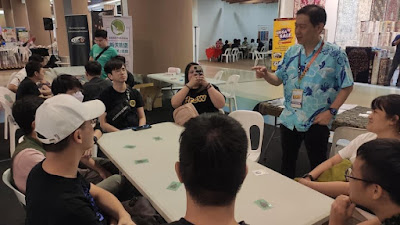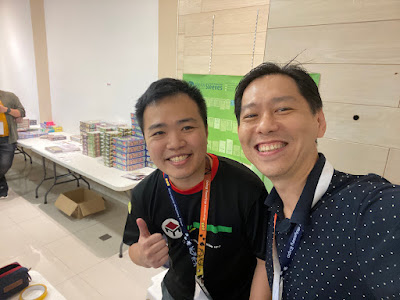26-27 Aug 2023 was BOXCON game convention in Malaysia. I joined the event as one of the local game publishers. I only one have published game, but that is enough to qualify. I was at the Any Games convention at the end of July. This time round, there was enough space for me to fully display my bunting. Previously space was limited and I could only place my bunting behind my booth, so the bottom third was blocked from view. This time I was able to take a full-body shot with it.
The convention was held at Strand Mall. I arrived early on Saturday morning. Even the lights were not turned on yet. My booth was at a good spot, almost directly facing the main entrance. The Cili Padi Games bunting can be seen clearly from the main entrance.

I may look like the disciplinary teacher scolding students, but I was actually teaching a game - Snow White and the Eleven Dwarfs. This is the game I want most to promote this time, because this is my next game I'm planning to release in December 2023. I hope to introduce it to more people and create some anticipation. One challenge is the minimum player count is 7. This makes it difficult to gather enough people to play. On Day 1 of the convention, I only managed to get Snow White played near closing time. When I did get it to the table, I was pleased to see it continue to work well. Players were immediately absorbed, because this is a game that requires concentration. I think the premise is also something that attracts people to want to try the game.
At the end of Day 2, when I was about to pack up and leave, a group came and said they had been wanting to play Snow White. They asked whether I could stay a little bit longer so that they could play. I was certainly happy to oblige. They had noticed the game earlier, just that they didn't have enough people earlier, or I was busy teaching other groups other games. They made an effort to catch me before I left to try Snow White. That made my day.

I managed to get my business card done just in time for the convention. When I was at the Any Games convention, I realised that not having my own business card was rather amateur. So I decided to get mine done for BOXCON. Time was tight. The two conventions were less than a month apart. I asked Edwin (who did the art for Dancing Queen) to design the business card. Once the design was finalised, I went online to place an order with a business card printing service. The cards arrived just one day before the convention. Just In Time! I do love this design from Edwin.
This time tablecloths were not provided, so I brought my own. This particular tablecloth has been used for boardgaming for close to twenty years. When I take photos of boardgames for my blog, this tablecloth often appears in the background. It is getting much more exposure than I am.
I brought five different games. Of these five, Dancing Queen was the only game already published. The rest were prototypes at different stages of development. They were all at playable stages, but they were at different levels of maturity. Playing my prototypes with many different people is important to me. It gives me ideas to improve my games. It helps me assess whether my games are up to standard to be worth publishing.
The next game I plan to publish is Snow White and the Eleven Dwarfs. The images I am using for my prototype are found on the internet, i.e. other people's art. I have started work on my own art. Edwin who did the art for Dancing Queen will be doing the art for me. I am looking forward to a different kind of Snow White and dwarfs.
This above is my prototype Catch 22. I used characters from Miyazaki Hayao movies, but the game has nothing to do with these characters or the movies. This was a game which started from mechanism and not theme. I slapped on a cute theme just to make the prototype pretty. Catch 22 will probably be the next game after Snow White, i.e. it will be my publishing project for 2024. It is the more popular one among my current prototypes. I determine so by observing playtesters' behaviour when they play. Also sometimes some playtesters explicitly tell me they like this.
I had not been giving the theme much thought. Now that this might be my next project, I knew I needed to give it some thought. I discussed with Jeixel, and one suggestion he gave me was Jack and the Beanstalk. Jack is stealing treasures from the giant's home, and needs to escape before he is caught. Catch 22 has a risk escalation mechanism. Eventually I decided to change the name to Ali Baba and the Forty Thieves. I use fairy tales as the themes for my games because they are recognisable and relatable. They are inviting, and spark curiosity.

The story now is you players are Ali Baba's cousins. You see the fellow suddenly becoming rich, so you pester him to share his secret. He reluctantly tells you about the secret hideout of the forty thieves. So now you are at the cave grabbing as many treasures as you can before the thieves return to their den. Whoever happens to be the one still left behind when the thieves return will need to drop everything and run for their life. What do you think of the new name and theme?
This is a design I started recently, initially called Liar's Deck, in honour of the game Liar's Dice. This too is a mechanism-first design. Again, I did not try to come up with a theme when I made the first prototype. I just looked for pretty pictures from the internet to be used in the prototype. This game has nothing to do with cute Japanese anime-style cars. The game does involve lying, thus the initial name. Because of that, the most appropriate fairy tale to use would be Pinocchio!
So here's the updated prototype. I am calling this simply Pinocchio. I couldn't find a complete set of pretty pictures featuring Pinocchio and characters in the story. So I collected different versions of Pinocchio drawn by different artists in different styles and put them all into my new prototype.
BOXCON 2023 was the first public appearance of both Pinocchio and Ali Baba.
My ex-colleagues and old friends Calvin, Zong Zhan and Zhi Nin came to visit. It was great to catch up with them. They tried quite many of my games. One other ex-colleague Alex also came to visit. He didn't know beforehand I would be there. He found out about the event and was interested to attend. He was half expecting I might be there.
These two players enjoyed Dancing Queen so much that later that day they came back to play it again. This was very encouraging. When they won they would sing aloud "What is love.... Baby don't hurt me, don't hurt me.... no more", and also "You are the dancing queen... " It was a good move to name the cards in the game popular song names. I was also glad to see that they developed some tactics quickly, some of which took me many plays to work out when I was designing the game. These guys are sharp! It's a wonderful feeling seeing players appreciate my game to this level of depth.
This was Snow White, and this was the group which came to play at the end of Day 2 when I was about to pack up and leave.
Most of the other tables had been cleared, and this group stayed on to play Snow White. They played a few games while I continued to pack up my other stuff. After teaching them the rules, they were able to manage by themselves. This is after all not a very complicated game.
Throughout BOXCON I mostly obediently stayed at my booth and did not go about trying other designers' games. I did make some rounds to take a quick look at what were available. The only game I tried was Jalan Raya, a local design still at the prototype stage. Choon Ean and I visited the booth together to try it out. This is an open information abstract game. Clean and simple design, refreshing. Something a little different from the usual fare.






















































